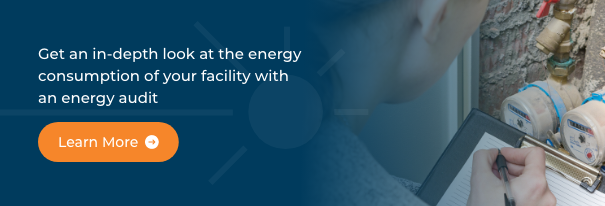During the winter months, many businesses and schools may experience peak utility bills and overall energy usage as building systems work to keep up with the demands of heating and proper temperature control. Old heating, ventilation and air conditioning (HVAC) systems can often be the root cause of poor energy utilization, as well as outdated lighting components and fixtures, damaged or broken window seals, and aging building structures that have not been maintained.
No matter the reason, it’s important for business owners and facility managers to take time to explore ways to reduce energy usage and address issues to help increase the comfort levels of building occupants while also reducing financial expenses.
Our team of professionals at SitelogIQ offer five ways that businesses and school districts can reduce their overall energy consumption and usage while also reducing their carbon footprint and operating expenses.

1. Switch to Energy Efficient Lighting Solutions
It is estimated that close to 40 percent of all energy usage of a building can be attributed to lighting costs. Businesses and school districts can drastically reduce their usage by installing energy-efficient lighting solutions, which transforms the quality of your occupants’ experience and reduces your energy and maintenance costs.

2. Install Programmable Thermostats
With so many advances in heating systems technology, don’t leave the responsibility of adjusting the thermostat to the last person leaving the office or classroom at the end of the day. For businesses and schools that want to identify immediate ways to lower heating (and subsequently cooling) costs, programmable thermostats, and more specifically, integrated building automation systems, should be installed. These systems are pre-set within comfortable temperature ranges based on occupancy and usage and can even be monitored in real-time to alert owners of any issues.
3. Utilize Motion Detectors and Automatic Dimmers
Every building has at least one or two rooms – perhaps a kitchenette or an under-used conference room – where the light always gets left on for several hours or even overnight. This can lead to wasted energy usage and ultimately, higher energy costs. Businesses and school districts should consider investing in motion detectors and automatic dimmers to ensure that lights are not left on unnecessarily.
4. Inspect Elements of Your Building Envelope
A building envelope is essentially the physical barrier between the interior of a building and the exterior environment. Generally, the building envelope is the roof, walls, doors, windows and foundation of a structure. It’s important to inspect areas that may be vulnerable to heat loss such as gaps in windows and cracks in the ceiling or roof. A professional inspection is recommended to ensure a thorough review of the envelope.
5. Conduct an Energy Audit
In order to make an informed decision about how to reduce energy usage and an organization’s impact on the environment, business owners and school administrators should consider a full energy audit of their buildings. This is the first step to a comprehensive energy savings plan. Audits may include a full inspection of a building to assess systems and structure, data analysis and review of utility bills and costs, and recommended improvements or upgrades to maximize building efficiency. A thorough audit can present companies with a formalized approach to energy management.

How SitelogIQ Can Help
SitelogIQ, an Energy Star partner, can help school districts and businesses throughout the U.S. assess their energy usage and offer recommendations to maximize building efficiency. If you are ready to discuss these and other ways to save on energy costs, or conduct an energy efficiency audit or study, contact us today. We can answer questions and share more about the results we can help you achieve. We’re the facility experts who can deliver tremendous value through an energy efficiency audit or study. We’re ready to discuss your buildings and their energy needs at any time.


